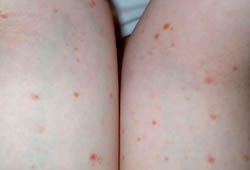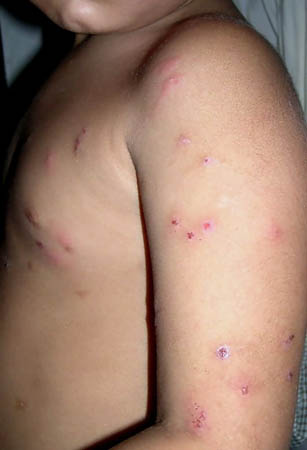Resumo
Definição
História e exame físico
Principais fatores diagnósticos
- erupção cutânea aguda a subaguda recorrente
- erupção cutânea não pruriginosa, generalizada e polimórfica
Outros fatores diagnósticos
- cicatrizes ou mudanças de pigmentação
- imunossupressão
- doença recente
- história familiar de pitiríase liquenoide
- cefaleia
- mialgias/artralgias
- mal-estar
- queimação/prurido
- insuficiência de múltiplos órgãos
Fatores de risco
- da infância ao início da fase adulta
- sexo masculino
- vírus da imunodeficiência humana (HIV)
Investigações diagnósticas
Primeiras investigações a serem solicitadas
- dermatoscopia
- biópsia de pele
Investigações a serem consideradas
- títulos de antiestreptolisina
- Antígeno do capsídeo viral IgM/IgG do vírus Epstein-Barr e anticorpo contra o antígeno nuclear
- monoteste ou teste de anticorpos heterófilos
- teste para o antígeno de superfície da hepatite B, anticorpo antissuperfície e IgM anti-core
- anticorpo do vírus da hepatite C
- Rastreamento para vírus da imunodeficiência humana (HIV)
- reagina plasmática rápida
- culturas faríngeas
- teste de reação de Sabin-Feldman para toxoplasma, hemaglutinação/imunofluorescência indireta
- velocidade de hemossedimentação
- proteína C-reativa
- lactato desidrogenase (LDH) sérico
- contagem leucocitária
- albumina sérica
Algoritmo de tratamento
doença leve a moderada
doença grave ou resistência ao tratamento
Colaboradores
Autores
Amy Musiek, MD
Professor of Dermatology
Division of Dermatology
Washington University School of Medicine in St. Louis
St. Louis
MO
Declarações
AM is a paid lecturer in cutaneous T-cell lymphoma for Dermatology Week, is the author of the UpToDate article on Pityriasis lichenoides chronica, and is an investigator for multiple industry sponsored studies all unrelated to pityriasis lichenoides.
Agradecimentos
Dr Amy Musiek would like to gratefully acknowledge Dr Amer Khachemoune and Dr Marianna Blyumin-Karasik, previous contributors to this topic.
Declarações
AK and MB-K declare that they have no competing interests.
Revisores
Andrew D. Lee, MD
Resident
Department of Dermatology
Wake Forest University School of Medicine
Winston-Salem
NC
Declarações
ADL declares that he has no competing interests.
Abdulhafez Selim, MD
Assistant Professor
King Fahd University of Petroleum and Minerals
Dhahran
Saudi Arabia
Declarações
AS declares that he has no competing interests.
Créditos aos pareceristas
Os tópicos do BMJ Best Practice são constantemente atualizados, seguindo os desenvolvimentos das evidências e das diretrizes. Os pareceristas aqui listados revisaram o conteúdo pelo menos uma vez durante a história do tópico.
Declarações
As afiliações e declarações dos pareceristas referem--se ao momento da revisão.
Referências
Principais artigos
Khachemoune A, Blyumin ML. Pityriasis lichenoides: pathophysiology, classification, and treatment review. Am J Clin Dermatol. 2007;8(1):29-36. Resumo
Bowers S, Warshaw EM. Pityriasis lichenoides and its subtypes. J Am Acad Dermatol. 2006 Oct;55(4):557-72; quiz 573-6. Resumo
Bellinato F, Maurelli M, Gisondi P, et al. A systematic review of treatments for pityriasis lichenoides. J Eur Acad Dermatol Venereol. 2019 Nov;33(11):2039-49. Resumo
Jung F, Sibbald C, Bohdanowicz M, et al. Systematic review of the efficacies and adverse effects of treatments for pityriasis lichenoides. Br J Dermatol. 2020 Dec;183(6):1026-32. Resumo
Artigos de referência
Uma lista completa das fontes referenciadas neste tópico está disponível para os usuários com acesso total ao BMJ Best Practice.

Diagnósticos diferenciais
- Papulose linfomatoide
- Psoríase gutata
- Erupção por medicamentos
Mais Diagnósticos diferenciaisFolhetos informativos para os pacientes
Psoríase: quais são as opções de tratamento?
Psoríase: o que é?
Mais Folhetos informativos para os pacientesConectar-se ou assinar para acessar todo o BMJ Best Practice
O uso deste conteúdo está sujeito ao nosso aviso legal
